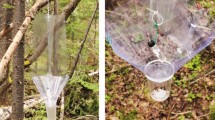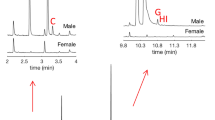Abstract
The Chinese white pine beetle, Dendroctonus armandi Tsai and Li, is one of the most destructive insects in natural and managed forests of Chinese white pine (Pinus armandii Franch.) in China. Female-produced volatiles, as aggregation pheromone candidates, and volatiles released from host pine trees, as possible kairomones, were collected via aeration and hindgut solvent extraction techniques, analyzed by gas chromatography–mass spectrometry (GC–MS), and assayed by field-trapping experiments in Shaanxi and Hubei provinces, China. GC–MS analyses showed that monoterpenes are the major volatile compounds from all aeration samples of P. armandii logs, with or without D. armandi attacks, accounting for >95 % of total volatiles. α-Pinene (63.18 %), Δ3-carene (14.4 %), β-pinene (7.9 %), limonene (6.2 %) and β-myrcene (3.85 %) were the major monoterpenes, while (+)-longifolene (1.1 %) was the most dominant sesquiterpene. Four bark beetle-related volatile compounds, trans-verbenol (tV; major component), exo-brevicomin (EBV), seudenol (SD), and 1-methyl-2-cyclohexen-1-ol (MCOL) were identified from both the aeration extracts of P. armandii logs with D. armandi females and their hindgut extracts. Our field bioassays showed that all four female-produced individual pheromone candidates and their possible combinations (binary, ternary and quaternary) were not significantly attractive to D. armandi. Two pheromone candidate blends [one ternary (tV/SD/EBV) and one quaternary (tV/SD/EBV/MCOL)], and a mixture of host terpene kairomone candidates were also inactive when tested alone. However, when the five major host monoterpenes and one sesquiterpene (mimicking the natural ratio) were combined with the pheromone ternary or quaternary blend, D. armandi trap catches were significantly (4–10 times) higher than captures in the blank control traps or traps baited with the individual blends, indicating a strong synergistic effect. These synergistically attractive semiochemicals are potentially of great utility for monitoring and mass-trapping this serious forest pest of Chinese white pine in western China.




Similar content being viewed by others
References
Borden JH, Ryker LC, Chong LJ, Pierce HD Jr, Johnston BD, Oehlschlager C (1987) Response of the mountain pine beetle, Dendroctonus ponderosae Hopkins (Coleoptera: Scolytidae), to five semiochemicals in British Columbia lodgepole pine forests. Can J For Res 17:118–128
Borden JH, Pureswaran DS, Lafontaine JP (2008) Synergistic blends of monoterpenes for aggregation pheromones of the mountain pine beetle (Coleoptera: Curculionidae). J Econ Entomol 101:1266–1275
Byers JA (1989) Behavioral mechanisms involved in reducing competition in bark beetles. Holarctic Ecol 12:466–476
Byers JA (1993) Randomization algorithms in BASIC for experimental design. Comput Biol Med 23:167–176
Byers JA, Zhang Q-H (2012) Chemical ecology of bark beetles in regard to search and selection of host trees. In: Liu T-X, Le K (eds) Recent advances in entomological research. Springer, New York, pp 150–190
Byers JA, Wood DL, Craig J, Hendry LB (1984) Attractive and inhibitory pheromones produced in the bark beetle, Dendroctonus brevicomis, during host colonization: regulation of inter-and intraspecific competition. J Chem Ecol 10:861–877
Chen H, Tang M (2007) Spatial and temporal dynamics of bark beetles in Chinese white pine in Qinling Mountains of Shaanxi Province, China. Environ Entomol 36:1124–1130
Chen H, Tang M, Gao J, Chen X, Li Z (2006) Changes in the composition of volatile monoterpenes and sesquiterpenes of Pinus armandii, P. tabulaeformis, and P. bungeana in Northwest China. Chem Nat Comp 42:534–538
Chen M, Li Y-H, Wang X-J (2007) Analysis of volatile constituents in Pinus armandii bark with GC/MS. For Res 20:428–432
Fettig CJ, Dabney CP, McKelvey SR, Borys RR (2006) An assessment of re-randomization methods in bark beetle (Scolytidae) trapping bioassays. Agri For Entomol 8:267–271
He M-J, Liao C-L, Guo H-J, He Y-S, Liao L-J, Wang H, Zhang Y, Zhang G-H (2009) Analysis of constituents of the volatile materials in the bark of Pinus armandii from Enshi. J Hubei Univ Natl 27:254–257
Hofstetter R, Chen Z, Gaylord M, McMillin J, Wagner M (2008) Synergistic effects of α-pinene and exo-brevicomin on pine bark beetles and associated insects in Arizona. J Appl Entomol 132:387–397
Hofstetter RW, Gaylord ML, Martinson S, Wagner MR (2012) Attraction to monoterpenes and beetle-produced compounds by syntopic Ips and Dendroctonus bark beetles and their predators. Agri For Entomol 14:207–215
Lanne BS, Schlyter F, Byers JA, Löfqvist J, Leufvén A, Bergström G, Van Der Pers JNC (1987) Differences in attraction to semiochemicals present in sympatric pine shoot beetles, Tomicus minor and T. piniperda. J Chem Ecol 13:1045–1067
Li Z-B, Chen H, Chen X (2006) Analysis of chemical constituents of volatile oil from resin of Pinus armandii. J Northwest For Univ 21:138–141
Li Y, Chen M, Ye H (2007) Relationship between volatile matters from Armand pine and endangerments of Armand pine bark-weevil. J Northeast For Univ 35:7–10
Lindgren B, Gries G, Pierce H Jr, Mori K (1992) Dendroctonus pseudotsugae Hopkins (Coleoptera: Scolytidae): production of and response to enantiomers of 1-methylcyclohex-2-en-1-ol. J Chem Ecol 18:1201–1208
Lindgren BS, Miller DR, Lafontaine J-P (2012) MCOL, frontalin and ethanol: a potential operational trap lure for Douglas-fir beetle in British Columbia. J Entomol Soc Brit Col 109:72–74
Liu Z, Xu B, Miao Z, Sun J (2013) The pheromone frontalin and its dual function in the invasive bark beetle Dendroctonus valens. Chem Senses 38:485–495
Miller DR, Borden JH (2000) Dose-dependent and species-specific responses of pine bark beetles (Coleoptera: Scolytidae) to monoterpenes in association with pheromones. Can Entomol 132:183–195
Payne T, Coster J, Richerson J, Edson L, Hart E (1978) Field response of the southern pine beetle to behavioral chemicals. Environ Entomol 7:578–582
Pu X-J, Chen H (2007) Relations between attacking of Dendroctonus armandi and nutrition and resistance material of host trees (Pinus armandii). J Northwest A F Univ 35:106–110
Pureswaran DS, Borden JH (2005) Primary attraction and kairomonal host discrimination in three species of Dendroctonus (Coleoptera: Scolytidae). Agric For Entomol 7:219–230
Pureswaran DS, Hofstetter RW, Sullivan BT (2008a) Attraction of the southern pine beetle, Dendroctonus frontalis, to pheromone components of the western pine beetle, Dendroctonus brevicomis (Coleoptera: Curculionidae: Scolytinae), in an allopatric zone. Environ Entomol 37:70–78
Pureswaran DS, Sullivan BT, Ayres MP (2008b) High individual variation in pheromone production by tree-killing bark beetles (Coleoptera: Curculionidae: Scolytinae). Naturwissenschaften 95:33–44
Rudinsky J, Kinzer G, Fentiman A, Foltz R (1972) trans-Verbenol isolated from Douglas-fir beetle: laboratory and field bioassays in Oregon. Environ Entomol 1:485–488
Ryall K, Silk P, Thurston G, Scarr T, de Groot P (2013) Elucidating pheromone and host volatile components attractive to the spruce beetle, Dendroctonus rufipennis (Coleoptera: Curculionidae), in eastern Canada. Can Entomol 145:406–415
Schlyter F, Birgersson G (1999) Forest beetles. In: Hardie J, Minks AK (eds) Pheromones in non-lepidopteran insects associated with agricultural plants. CAB International, Oxford, pp 113–148
Schlyter F, Zhang Q-H, Liu G-T, Ji L-Z (2001) A successful case of pheromone mass trapping of the bark beetle Ips duplicatus in a forest island, analysed by 20-year time-series data. Integr Pest Manag Rev 6:185–196
Seybold SJ, Huber DP, Lee JC, Graves AD, Bohlmann J (2006) Pine monoterpenes and pine bark beetles: a marriage of convenience for defense and chemical communication. Phytochem Rev 5:143–178
Sullivan BT, Dalusky MJ, Mori K, Brownie C (2011) Variable responses by southern pine beetle, Dendroctonus frontalis Zimmermann, to the pheromone component endo-Brevicomin: influence of enantiomeric composition, release rate, and proximity to infestations. J Chem Ecol 37:403–411
Wang K-Q, Wang X-B (2010) Dendroctonus armandi Control in Taibai Mountains. Shaanxi For Sci Tech 6:58–60
Wang X, Chen H, Ma C, Li Z (2010) Chinese white pine beetle, Dendroctonus armandi (Coleoptera: Scolytinae), population density and dispersal estimated by mark-release-recapture in Qinling Mountains, Shaanxi, China. Appl Entomol Zool 45:557–567
Wang R-L, Yang W, Yang Z-Z, Chen X-P, Yang C-P, Li Q, Li F, Chen C-M (2011a) Electroantennographic and behavioral responses of Dendroctonus armandi (Coleoptera: Ipidae) to host plant volatiles. Chin J Ecol 30:724–729
Wang R-L, Yang W, Yang Z-Z, Chen X, Wang XW, Yang C-P (2011b) Electroantennographic and behavioral responses of Dendroctonus armandi (Tsai et Li) to 9 plant volatiles. For Pest Dis 30:23–26
Wang X-W, Zhang Z-J, Yang W, Yang C-P, Li F (2014) A preliminary study of the biological character of Dendroctonus armandi. J Sichuan For Sci Tech 35:56–58
Wood DL (1982) The role of pheromones, kairomones, and allomones in the host selection and colonization behavior of bark beetles. Ann Rev Entomol 27:411–446
Wu SP, Chen H, Wu Q (2012) Volatile compounds in the frass of adult Chinese white pine beetle. J Northwest A F Univ 27:111–116
Xie S-A, Ding Y (2010) Semiochemicals of Dendroctonus armandi. J Northeast For Univ 38:91–94
Xie S-A, Lv S-J (2012) An improved lure for trapping the bark beetle Dendroctonus armandi (Coleoptera: Scolytinae). Euro J Entomol 109:569–577
Xie S-A, Lv S-J (2013) Effect of different semiochemicals blends on spruce bark beetle, Ips typographus (Coleoptera: Scolytidae). Entomol Sci 16:179–190
Yang X, Zhao H, Wang J, Meng Q, Zhang H, Yao L, Zhang Y, Dong A, Ma Y, Wang Z (2010) Chemical composition and antioxidant activity of essential oil of pine cones of Pinus armandii from the Southwest region of China. J Med Plant Res 4:1668–1672
Yin H-F, Huang F-S, Li Z-L (1984) Dendroctonus armandi Tsai & Li. Economic insect fauna of China (Coleoptera: Scolytidae), vol 29. Science Press, Beijing, pp 26–35
Zhang L, Chen H, Ma C, Tian Z (2010) Electrophysiological responses of Dendroctonus armandi (Coleoptera: Curculionidae: Scolytinae) to volatiles of Chinese white pine as well as to pure enantiomers and racemates of some monoterpenes. Chemoecol 20:265–275
Zhang L, Chen H, Chen X (2011) Effect of Dendroctonus armandi infection on the volatile constituents of Pinus armandii in Qinling Mountains. J Northwest For Univ 26:114–118
Acknowledgments
We thank Dr. Jeff Aldrich (Jeffrey R. Aldrich consulting, LLC, USA), Dr. John A. Byers (USDA-ARS) and Prof. Fredrik Schlyter (SLU, Sweden) for valuable comments and suggestions on an earlier version of this manuscript.
Author information
Authors and Affiliations
Corresponding author
Additional information
Handling Editor: Günther Raspotnig.
Electronic supplementary material
Below is the link to the electronic supplementary material.
Rights and permissions
About this article
Cite this article
Chen, G., Song, Y., Wang, P. et al. Semiochemistry of Dendroctonus armandi Tsai and Li (Coleoptera: Curculionidae: Scolytinae): both female-produced aggregation pheromone and host tree kairomone are critically important. Chemoecology 25, 135–145 (2015). https://doi.org/10.1007/s00049-014-0182-1
Received:
Accepted:
Published:
Issue Date:
DOI: https://doi.org/10.1007/s00049-014-0182-1




